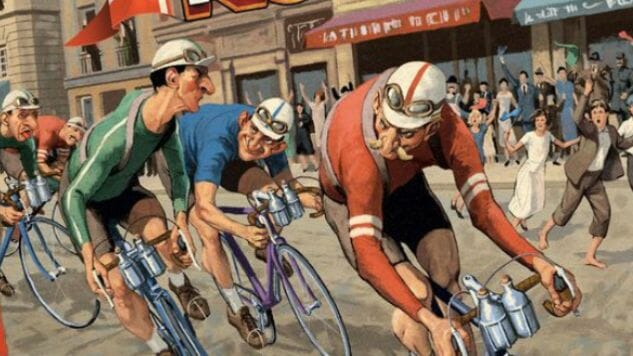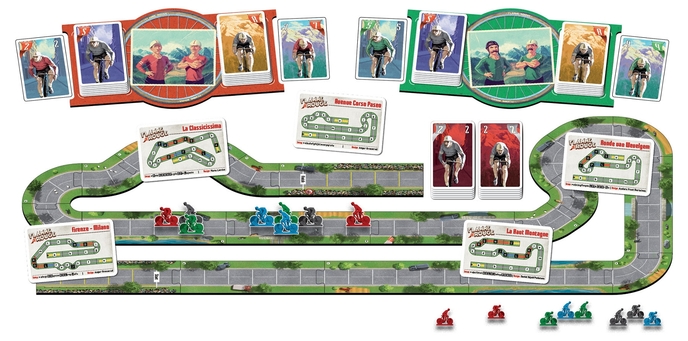
One of the biggest challenges for boardgame designers in this golden age of cardboard is ensuring games stay reasonably balanced throughout their play—that players who fall behind early at least have a reasonable chance to catch up through smart play and/or a little luck. La Flamme Rouge is the first game I’ve come across that turns this, as Walter Sobchak might say, into an ethos: The game actively pulls laggards up closer to the leader, which gives this game an entirely new feel despite simple rules and a quick playing time.
First released by a Finnish publisher last year and out this spring from Stronghold Games in English, La Flamme Rouge is a Tour de France-themed game in all but name (like that famous Springfield horror film, The Shinning), with two to four players controlling two bicyclists apiece on a long and variable racetrack. Each player then gets two decks of movement cards, one for each of your cyclists, with the Sprinteur deck containing cards with 2 to 9 movement points and the Rouleur deck containing cards with 2 to 7 movement points.
On a turn, each player draws four cards from his/her Sprinteur deck, chooses one to play on this turn, and “recycles” the other three face-up to the bottom of that deck. S/he then does the same thing with the Rouleur deck. Players all choose cards at the same time, and reveal them in the order in which the cyclist tokens appear on the track. You move your cyclist forward the number of spaces on the movement card you played, passing through other cyclists if needed but unable to end a turn on the same space as someone else’s token. The track has two lanes, so you can move your cyclist to the left lane if needed, but if the entire square (both lanes) is occupied, you must stop your cyclist in an open space behind those two. Played movement cards are removed from the game.
After every player has played his/her movement cards, the balancing mechanism kicks in. First, you “slipstream” any cyclist tokens who have exactly one empty space ahead of them on the track, starting from the read of the pack. You move any such cyclists up so that they’re directly behind whoever was in front of them, and continue doing so until you reach the front of the pack—so you can easily end up with all tokens bunched together even if there had been several empty squares after the movement cards were played.
Then you deal “exhaustion” cards, with movement values of 2, to any player with a token that has a completely empty square (both left and right lanes) in front of it after slipstreaming. Thus whoever is in the lead finds his/her deck of movement cards getting worse, filling up with 2 cards, and it’s quite possible to draw four 2s late in a game when you might be just a dozen or so spaces from the finish.
This informs any strategy for playing La Flamme Rouge; you don’t want to blow out your best movement cards early, and there’s value in playing cards just a bit below those your opponent plays so you can take advantage of the free movement of slipstreaming. Of course, everyone will try that trick, and someone’s still going to end up stuck with exhaustion cards, so you might as well drop some higher numbers if you’re going to get penalized anyway.
The track itself is variable and tiles are double-sided, with some tiles including mountains that change the way movement cards affect cyclists. Ascent squares negate any movement card with a value over 5, capping at that number, while Descent squares count any movement card below 5 as if it was worth 5. Cyclists on Ascent squares are also not subject to slipstreaming, either as recipients or as the force pulling other cyclists up.
La Flamme Rouge works best with three or four players; it works with two, but it’s a noticeably simpler experience and you miss the interaction with more players. It’s playable inside of a half hour, and setup is largely limited to getting the track tiles down in the right order. The rules are simple enough for younger kids, although I would guess you’d have to teach players under ten not to blow all their 7- and 9-cards in the early going. My only quibble with this game is that the plastic cyclist tokens, while meticulously made, are a bit fragile. It’s one of the best titles of the year and a great add for families or gaming groups with some players who tend to lose interest in games if they fall behind too quickly.
Keith Law is a senior baseball writer for ESPN.com and an analyst on ESPN’s Baseball Tonight. You can read his baseball content at search.espn.go.com/keith-law and his personal blog the dish, covering games, literature, and more, at meadowparty.com/blog.
